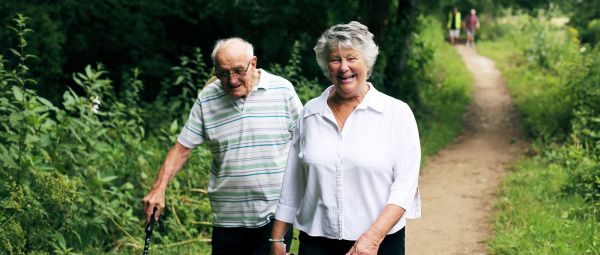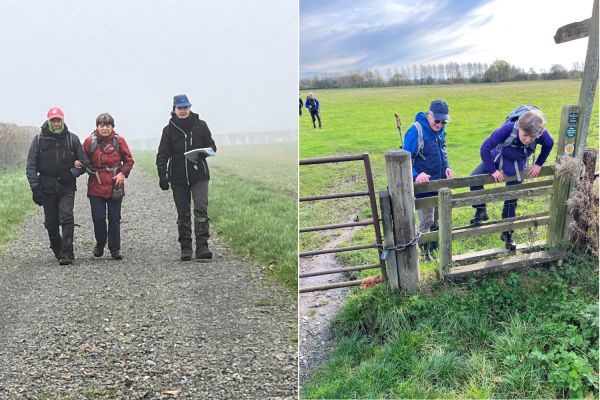A masterclass in sensory walks
Planning a ‘sensory walk’ – to stimulate touch, sound, sight, smell and even taste – creates a richer and more rewarding outing, and can also make walking more inclusive and accessible

Words: Andrew McCloy
Last year, Westonbirt Arboretum in Gloucestershire launched a series of guided walks to help visitors enjoy its spectacular collection of 15,000 trees and plants. Unusually, though, the walk leaders were visually impaired. The aim was to encourage people of all abilities to take their time, change their perceptions and explore the arboretum using their non-visual senses.
The arboretum’s Sensing Nature walks will take place twice a month until the end of September 2023. If you prefer to explore on your own, there are also two self-led sensory walks, called the Acer Glade and the Savill Glade. You’re encouraged to feel the mossy branches of the maples, smell the candyfloss scent of the katsura tree and listen to the rustle of bamboo swaying in the wind. ‘We touch the trees, we smell the trees, we explore them with our hands, we walk on them,’ explains Louise Rounds, volunteer guide. ‘It’s a totally immersive, interactive experience.’

‘My essential advice to walkers with vision would be to not just rely on your sight. Feel with your feet, listen to leaves rustling, listen to waterfalls, open yourself to your surroundings. When I’m walking, I’m always touching things: flowers, roots, trees. Once you explore with your senses, the world comes alive.’
Amar Latif (aka The Blind Adventurer), Ramblers president
Rambling is always a multi-sensory activity. We all know how a walk can come alive through the sound of birdsong and buzzing insects, the smell of wild garlic or the sight of a dazzling autumn palette of woodland colours. Dipping hot feet in a cool stream or tasting juicy blackberries fresh from the hedgerow can make for profound and lasting memories. But how often do we plan a walk to deliberately engage all our senses and heighten the experience of being up close with nature, or consciously pause to register what our body is feeling?
Alice Miller is a sport and physical activity coordinator with the charity Sense, set up to empower people who are deafblind or have complex disabilities. She believes that creating walking routes designed to stimulate our senses is a way to help everyone enjoy the benefits of rambling.
‘Sensory walks are simply about using all your senses to connect with the environment around you, to engage with nature and have a meaningful experience,’ she explains. ‘With proper planning, sensory walks can work in any setting, rural or urban, and allow people of all abilities to have a rich and rewarding time.’
Walking ‘in the moment’
A focus solely on the sensory aspects of a walk may seem quite narrow, but there’s plenty of evidence that points to the significant health and wellbeing benefits of being more in tune with your own body. Even though, as children, we learn so much through the stimulation of our senses, the pace and pressures of modern adult life make it all too easy for us to ‘live in our heads’ and lose touch with what our body is telling us.
Paying attention to the sights, sounds, smells and tastes of the present moment is often described as mindfulness. The wider physical and mental health benefits that flow from this, such as reducing stress and anxiety, not to mention a reconnection with nature and landscapes, is at the heart of sensory walking.
Whether you choose to frame it as mindfulness or meditation, sensory walking is first about being aware of your own body, how you’re feeling and being comfortable in yourself. Then you go on to be immersed in your immediate environment – noticing sensations such as sounds and smells – and the exact moment you’re in. If your mind wanders – and this is quite normal – you simply bring your thoughts back and refocus on the present moment and what you’re directly experiencing.
The notion of a focused and unhurried activity where you’re encouraged to concentrate on yourself, rather than interacting with others, may seem like anathema to many ramblers – especially on conversational group walks – but rambling has room for many different approaches. For example, on a warm summer’s evening last year, Manchester Weekend Walkers organised a ‘silent walk’ for a small group around Lyme Park near Disley, Cheshire.
‘Our group walks are usually very sociable, with plenty of chatter,’ says leader Cathryn McGarvey. ‘So I thought it would be interesting to encourage the same people to try to walk silently together for a couple of hours. Most said afterwards that they found it relaxing and comfortable. One or two remarked that it was nice not to feel pressured to engage, and instead to quietly enjoy each other’s company and absorb the surroundings.’
Why develop a sensory walk?
Devising a walk with opportunities to engage as many senses as possible can bring benefits that go beyond enriching the experience for you or your group. A carefully thought-out sensory walk can widen the reach and appeal of rambling to people who don’t normally participate, including those with visual impairments or learning disabilities, as well as children and teenagers. It can be a way of connecting with other local community groups or attracting new participants to your walking festival, as well as broadening the scope of a regular walks programme.
London Blind Ramblers has been enjoying walks in and around the capital for more than 40 years. Joint walks organiser Valerie Clark, the sighted partner of blind husband David, explains that many of their outings are planned and led for them by different Ramblers groups. ‘They’re not designed as out-and-out sensory walks and we certainly enjoy good conversations and make friends,’ she says. ‘But they’ve taken us from scented lavender fields in Surrey to the wonderful textured tree trunks of Epping Forest. Plotting attractive routes like these, which are also designed to avoid hazards and difficulties – such as narrow waterside paths, uneven surfaces and stiles – helps groups to understand and accommodate ramblers with different needs. And, of course, everyone benefits.’
How to plan your own sensory walk
There’s plenty of useful advice about planning and leading a sensory walk in a free toolkit produced by Sense. But Alice says early engagement is key. ‘First, find out about the needs of your walk participants. Get to know them, so you understand their physical requirements, how to communicate and how they want to be engaged on the walk.’
There are obvious practical and safety considerations around length, terrain and accessibility, but sensory walks don’t have to be long or head to a specific destination, nor require any special equipment. Best of all, they can take place in almost any habitat or setting.
‘Woodland is great for sounds and touch,’ says Alice, ‘and at the seaside you have the overlap of smell and taste in the salty air, the crashing sound of waves and the crunch of shingle or sand underfoot. But a town or city walk can work, too, with the sounds of people and transport, or the smells of a coffee shop or bakery.’
While sensory walks are certainly about being active and outdoors, it’s important that participants are also given the space and time to focus and become aware of their own bodies (maybe by standing or sitting still and trying different breathing exercises), and are encouraged to fully engage all their senses. This can include touching natural objects, such as stones and leaves; feeling the warmth of the sun on their skin; smelling flowers; listening to the noise the wind makes; and, if practical and safe, tasting natural produce, such as berries. Sight, meanwhile, is about the texture and shape of close-up objects, as well as clouds or far-off views.
Whatever your ability and wherever you choose to go, fully switching on your senses can make for a magical walking experience. Valerie recalls a hot summer’s day walk around the Royal Botanic Gardens in Kew, London, with a walk leader (who, fortuitously, was also an official guide at Kew) from the London-based Polytechnic Rambling Club. ‘Everyone, blind and sighted, commented on the scent of the flowers and the noise of the bees and other insects, the heat and humidity of the glasshouses, and the different types of path we were taken down. It was such a memorable walk.’ And the best sensation of all? ‘The deliciously cold and intensely fruity ice cream at the end of the walk!’
How to be mindful on a walk
Try these tips on your own or with others on a group walk
• Consider how you’re feeling – try to just notice, without making any judgements.
• Stand or sit still for a moment – focus on a sound or object far away and gradually bring it into your body.
• Take a moment to focus on one thing intently – then describe the look, touch or sound of it to others.
• Start your walk slowly to slow your thoughts; be present in the moment and aware of your body.
• Try breathing exercises – inhale deeply and slowly, and notice the smells around you, or hold your breath then exhale slowly.
Sensory walks for children
Incorporate some of these activities to make your walk fun, creative and engage all the senses
• Try crayon rubbings using different trees – leaves as well as trunks.
• Make nature mandalas (circular patterns) on the ground using leaves, stones or twigs.
• Devise a sensory nature hunt, including the smells of plants and sounds of wildlife.
• Create a nature paintbrush out of natural materials using a stick as a handle and elastic bands to fasten.
• Create a shaker by placing different items in a container, then listen to the sound when gently shaken.

Disability and public access
Spending time outdoors in nature should be easy, accessible and enjoyable for all. But our paths, tracks and trails are not always accessible to everyone.

Planning a walking route
Choosing the location and distance are just two important aspects of planning a walking route. Here is our guide to a well-planned walk.

Walking is about more than what you can see
Ramblers member Marika has been blind since childhood, but that hasn’t stopped her from enjoying walking.